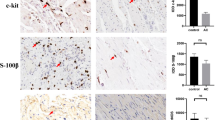Abstract
Internal anal sphincter achalasia (IASA) is a condition with a clinical presentation similar to Hirschsprung's disease, but with the presence of ganglion cells on rectal biopsy. The diagnosis of IASA is made on anorectal manometry, which demonstrates the absence of a rectosphincteric reflux on rectal balloon inflation. In order to understand the nature of neuronal abnormalities in this condition, we performed immunohistochemistry using PGP 9.5 (a general neuronal marker) and synapsin I (a presynaptic marker) in IAS specimens from 10 patients with IASA and 8 normal controls. In the IAS of normal controls, there were many PGP 9.5 and synapsin I-positive nerve fibers. In IASA PGP 9.5-immunoreactive fibers were markedly reduced and synapsin I-positive fibers were either absent or markedly reduced. Our findings demonstrate that the IAS in achalasia patients has defective intramuscular innervation as well as defective innervation of the neuromuscular junction, thereby contributing to the motility dysfunction.
Similar content being viewed by others
Author information
Authors and Affiliations
Rights and permissions
About this article
Cite this article
Oue, T., Puri, P. Altered intramuscular innervation and synapse formation in internal sphincter achalasia. Pediatr Surg Int 15, 192–194 (1999). https://doi.org/10.1007/s003830050552
Issue Date:
DOI: https://doi.org/10.1007/s003830050552




